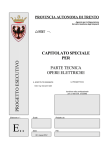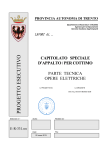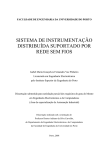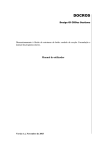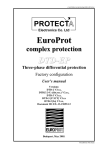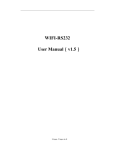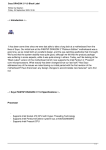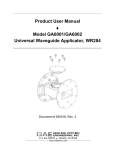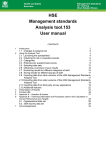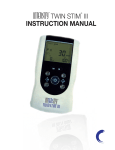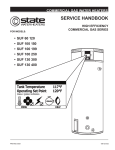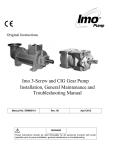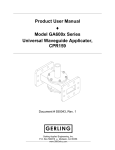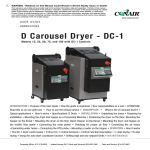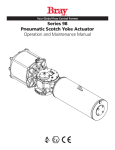Download Installation Guidelines for Power Drive Systems
Transcript
GAMBICA / REMA Technical Guide Variable Speed Drives & Motors Installation Guidelines for Power Drive Systems Fourth Edition : 2012 Installation Guide for Power Drive Systems Fourth Edition © GAMBICA/REMA 2012 FOREWORD This Technical Report has been produced to meet a demand for an authoritative guide on best practice for the installation of Power Drive Systems. It is the result of a study carried out by GAMBICA and REMA, taking note of well-established fundamental theory, technical papers, and carrying out specific investigations. The information given, while it can be applied to motors and inverters in general, is specific to current generation products of member companies. The Technical Report principally considers the aspects of safe mechanical and electrical installation and the avoidance of EMC problems. This report covers motors and inverters installed with a separate cabl ing system connecting the components together; it is not wholly applicable to inverters integrated into a motor design, which are now generally available up to 7.5 kW. The references together with a useful list of further reading are included in the final section of this report. SCOPE This report provides information on the basic principles that require to be considered when specifying, and installing, a power drive system. Supplies considered are low voltage up to 690 V a.c. The installation procedures detailed are specifically oriented to current United Kingdom practice. For the application of a power drive system incorporating Ex. motors, refer to the motor manufacturer for confirmation of their suitability and certification. SUMMARY Satisfactory operation of a drive system is dependent on a satisfactory installation. Not only must the motor and converter be mounted in accordance with the manufacturer’s requirements, but they must also be adequately cooled, effectively cabled and earthed. Compliance with the appropriate EU Directives and with local regulations is also a legal requirement. Specific sections in this report cover the requirements for the various parts of a power drive system, to assist specifiers and purchasers of drive systems f rom the specification phase to the installation and final commissioning. CONTENTS FOREWORD 1 SCOPE 1 SUMMARY 1 Section 1 INTRODUCTION ..................................................................................................... 4 1.1 1.2 1.3 1.4 1.5 Section 2 THE POWER DRIVE SYSTEM THE MOTOR AC VARIABLE SPEED DRIVES THE TRANSFORMER THE CABLES THE MECHANICAL INSTALLATION THE MACHINERY DIRECTIVE SAFETY ENVIRONMENT 2.3.1 MOTOR 2.3.2 MOTOR INSTALLATION: 2.3.3 CONVERTER 2.3.4 TRANSFORMERS 2.4 CABLES 2.5 EQUIPMENT SITING 2.5.1 MOTOR 2.5.2 CONVERTER 2.5.3 COOLING REQUIREMENTS Section 3 THE ELECTRICAL INSTALLATION 4 5 5 6 6 6 2.1 2.2 2.3 6 6 7 7 8 10 10 11 11 11 12 12 13 3.1 3.2 13 13 14 14 15 15 15 15 18 19 19 20 20 21 22 22 THE LOW VOLTAGE DIRECTIVE BASIC REQUIREMENTS 3.2.1 GENERAL REQUIREMENTS 3.3 THE TRANSFORMER 3.3.1 POWER CONDITIONERS 3.4 POWER CABLE TYPES 3.4.1 DRIVE SUPPLY CABLE 3.4.2 DRIVE MOTOR CABLE 3.5 CABLE RATINGS 3.5.1 SUPPLY AND MOTOR CABLES 3.6 SUPPLY CABLE 3.7 MOTOR CABLE 3.8 CIRCUIT PROTECTION 3.9 HIGH POWERS/CURRENTS 3.10 CABLE CONNECTION POINT 3.11 LOCAL TO MOTOR ISOLATION 3.12 3.13 3.14 3.15 OUTPUT CIRCUIT SWITCHING CABLE GLANDING POWER FACTOR CORRECTION CONTROL CONNECTIONS 3.15.1 ANALOGUE SIGNALS 3.15.2 DIGITAL SIGNALS 3.15.3 SERIAL COMMUNICATION SIGNALS 3.15.4 ENCODER CABLES 3.15.5 SEGREGATION Section 4 EARTHING 22 22 23 23 23 25 25 25 25 26 4.1 26 26 26 27 27 27 27 28 28 5.1 5.2 5.3 5.4 5.5 5.6 5.7 5.8 5.9 5.10 5.11 THE EMC DIRECTIVE STANDARDS MOTORS CONVERTERS TRANSFORMERS CABLES FILTERS EARTH CONDUCTORS PRACTICAL EXAMPLES OF EMC AND PRODUCT SELECTION HARMONICS RESPONSIBILITIES 5.11.1 MANUFACTURER 5.11.2 PANEL BUILDER 5.11.3 SYSTEM INTEGRATOR/INSTALLER 5.11.4 USER Section 6 PROBLEM INSTALLATIONS 28 30 31 31 31 31 32 32 32 34 34 34 34 34 34 35 Section 7 REFERENCES AND ACKNOWLEDGEMENTS 41 SUPPLY CONNECTIONS 4.1.1 EARTHED SECONDARY (TN, TN-C, TN-S) 4.1.2 UNEARTHED SECONDARY (IT) 4.2 EARTH FAULT PROTECTION 4.2.1 SUMMATION PROTECTION 4.2.2 INSULATION MONITORING 4.2.3 EARTH LEAKAGE PROTECTION 4.3 EARTH LOOP IMPEDANCE TESTING Section 5 EMC ISSUES Installation Guide for Power Drive Systems Section 1 INTRODUCTION 1.1 THE POWER DRIVE SYSTEM A power drive system (PDS) is a concept used by a number of standards. It consists of a Complete Drive Module (CDM) and a motor, together with its interconnections, it does not include driven load. In turn the CDM consists of a Basic Driv e Module (BDM) and its possible extensions such as the feeding section or some auxiliaries (for example ventilation). The BDM contains the electronic power converter, control and self-protection functions. Figure 1 shows the boundary between the PDS and the rest of the installation and/or manufacturing process 1 Installation or part of installation Power Drive System (PDS) CDM (Complete Drive Module) System control and sequencing BDM (Basic Drive Module) Control Converter and Protection Feeding section Field supply Dynamic braking Auxiliaries, others ... Motor and sensors Driven equipment Figure 1 - The Power Drive System 1 . IEC 61800 part 1, 2 and 4 give details for these definitions . Page 4 of 41 Installation Guide for Power Drive Systems For the purpose of this guide, the cabling from the supply is also considered, as the selection of suitable cables is often a problem, especially when dedicated feeding transformers are installed. 1.2 THE MOTOR The vast majority of motors sold today are squirrel cage induction motors; they are widely available, robust and efficient. When installed in accordance with the simple guidelines given, they can be used in conjunction with a voltage source PWM drive to give a highly satisfactory variable speed drive system. Specific requirements for motors are detailed in GAMBICA/REMA Technical Reports 1 and 2, which discuss winding insulation and bearing currents. 1.3 AC VARIABLE SPEED DRIVES Variable speed a.c. drive systems as illustrated below are used in ever -increasing numbers because of their well-known benefits for energy efficiency and flexible control of processes and machinery using low-cost maintenance-free a.c. motors. Virtually all a.c. drives use power-switching techniques and generate high rates of change of voltage. Supply Transformer Feeding Equipment Frequency Supply Cable Converter Motor Cable Motor Rectifier DC Link Inverter Control HMI Junction Box Or Isolator (if fitted) Factory Earth Control Cables Motor auxiliaries Figure 2 Power Drive System Most modern a.c. drives incorporate a Basic Drive Module based on a voltage -source PWM inverter with very fast-switching power semiconductor devices such as Insulated Gate Bipolar Transistors (IGBT), which have the advantage of being very robust and having relatively low switching losses. The nature of the voltage generated by such an inverter incorporates a certain degree of high frequency “noise”, which can lead to problems with Electromagnetic Compatibility (EMC). The rectifier also presents harmonic currents back to the network, which must be taken into account when designing a system. Page 5 of 41 Installation Guide for Power Drive Systems 1.4 THE TRANSFORMER While most power drive systems are fed at low voltage from a supply shared with other equipment, there is occasionally a requirement to utilise a dedicated transformer in association with the drive. 1.5 THE CABLES Cabling is one of the most critical areas of a good installation. Section 2 THE MECHANICAL INSTALLATION 2.1 THE MACHINERY DIRECTIVE Any installation in Europe must comply with the EU Machinery Safety Directive, which is designed to ensure safety for any user or operative. EU Directives do not have the force of law in themselves - In the event of any problem in the UK, it is only the appropriate Statutory Instrument passed by the UK Parliament, which has force of law. The Machinery Directive is known by the number 2006/42/EC under which it was published in the Official Journal of the EU. The UK national legislation, which implements it, is in the form of Statutory Instruments. The Directive defines a machine as an assembly, fitted with or intended to be fitted with a drive system other than directly applied human or animal effort, consi sting of linked parts or components, at least one of which moves, and which are joined together for a specific application The Power Drive System is clearly, therefore, a part of a Machine. The Directive also uses the concept of a safety component, and certain Power Drive Systems may have safety related features, and are termed Safety Related Power Drive Systems (or PDS(SR)). A specific GAMBICA Guide to the application of these has been published. 2 To implement the Directive a number of standards are published – well over 400 are currently listed on the EU website. CE Marking is the method used within the EU to indicate compliance with the appropriate directives for a particular item offered for sale; the presence of a CE Mark generally means that the equipment meets the relevant requirements. A generalpurpose PDS is not a complete machine, so it cannot carry a CE mark under the Machinery Directive. It should however, be delivered with appropriate declarations showing the standards that have been met. A drive with safety functions, i.e. a PDS(SR), does require a CE mark under the Machinery Directive. The GAMBICA Guide to CE Marking provides further information on the application of the appropriate regulations. 3 2.2 SAFETY A framework of standards regarding safety exists and the machinery manufacturer must identify the hazards associated with his specific equipment together with the corresponding safety requirements; he alone is in a position to do so. 2 GAMBICA Technical Guide, Variable Speed Drives and Functional Safety of Machinery 3 GAMBICA Technical Guide, CE Marking and Technical Standardisation, Guidelines for application to Electrical Power Drive Systems Page 6 of 41 Installation Guide for Power Drive Systems The principle is to ensure that the risk associated with the system is acceptable , by undertaking risk analysis on the machine to identify potential hazards throughout its life cycle, and where necessary to minimise them. The basic standards require that the PDS must be capable of being isolated whilst other hazards may require emergency stopping of the drive system, either by freewheeling to a stop on removal of power, or by active braking. The location and type of any safety related requirements, such as emergency stopping, must be defined at the outset of the project. In addition to these purely mechanical considerations for safety, the electrical safety of the system must also be considered (See Section 3) 2.3 ENVIRONMENT The location of the parts of the power drive system must be co nsidered, including Altitude Ambient Temperature Humidity Possibility of condensation Ventilation Access Vibration Airborne contamination Noise Electrical Power Quality 2.3.1 MOTOR Induction motors are very widely used around the world as prime movers in indu strial, domestic and building environments. To acquire the greatest benefit from them, in terms of trouble-free operation and long life, it is very important that utmost attention is paid to all aspects of their installation. This becomes even more vital if motors are to be driven from an inverter supply, the nature of which could lead to unforeseen problems such as excessive vibrations, noise, bearing failures, insulation damage, mechanical damage, electrical or thermal overloading etc., if due care is n ot exercised. There are many ways of mounting motors. They can be foot or flange mounted and mounting position can be horizontal or vertical with shaft up or down, or inclined . The mounting method and orientation must be specif ied to the motor manufacturer. Normally, the motors are mounted on foundations, which must be solid, rigid and level. Slide rails, sunken bolts, and metallic base plates may be used to secure them to the foundations. Direct-coupled motors can be mounted on bedplates or soleplates grouted in the foundations, or on pads or rods in special applications. When transmission is via belts, it is normal to use slide rails or an adjustable base, which permits the belt to be Page 7 of 41 Installation Guide for Power Drive Systems tensioned by moving the motor. Avoid the types of belt that are likely to become electro-statically charged. Usually the location of the driven load will govern the location of the motor, and in general a wide range of motor enclosures are available to cope with the range of environments to be encountered. The correct level of ingress protection should be selected by reference to the appropriate standards. 0 Special attention should be paid to areas with particularly high (> 40 C) and low 0 (<10 C) ambient temperatures, when special considerati on may be required to ensure adequate cooling, lubrication, etc. Attention should also be paid to installations where considerable levels of water spray are present, such as in cooling towers, to prevent ingress through the bearing seals. In all these cases the motor manufacturer should be consulted to enable a suitable solution to be selected. 2.3.2 2.3.2.1 MOTOR INSTALLATION: COUPLING The transmission of power from the motor shaft to the driven equipment is achieved in a number of ways, broadly classed as solid and f lexible. Solid couplings lock the two shafts together allowing no relative motion between them; some axial adjustment is possible at assembly. They are used when accuracy and fidelity of torque transmission are of paramount importance, for instance, when the phase relationship between driver and driven equipment must be accurately maintained. Flexible couplings, depending on their individual design, can absorb a degree of axial, angular, parallel and torsional misalignment between the shafts. It is nevertheless important that during setting up of alignment, the manufacturer’s instructions are strictly followed. Whatever couplings are used, they should be aligned very carefully in all three planes. The shaft centres should be correctly aligned when in normal use so that they are coincident. The value of good alignment cannot be over -estimated. Poor alignment can be a major source of noise and vibrations. It may damage bearings, possibly shear a shaft and quickly ruin a flexible coupling. To ensure correct alignment, the manufacturers’ instructions must be followed. Allowance must always be made for shaft end-float and thermal expansion in both axial and radial directions. Page 8 of 41 Installation Guide for Power Drive Systems Figure 3 - Belt driven fan assembly Spline or gear-type couplings generally should be aligned by procedures similar to that of solid couplings. Coupling hubs should be heated in an oil -bath or oven prior to fitting; gas torches must never be used. Belt drives have the motor mounted on slide rails or an adjustable base to permit retensioning of the belt by moving the machine. Whether it is flat -belt drive or V-belt drive, any limitation on pulley ratio and bearing radial loading must be strictly observed. Never overtension a drive belt. Careful attention to the design of belt drives in highly dynamic applications is always required. 2.3.2.2 BEARINGS It is normal practice for motors to be ready to run when despatched from the works and there should be no need for the bearings to be greased . In the case of nonshielded bearings, re-greasing facilities are provided as standard. Shielded bearings have sufficient grease to last over two years in normal operation. However, the manufacturer’s instructions should always be consulted before putting a motor into operation and when establishing the motor’s service schedule. If any motor has been stored for a long period, it may be necessary to rotate the shaft in accordance with the manufacturer’s recommendations. It may be necessary to regrease the bearings with compatible grease before it is commissioned and this should be done in accordance with the manufacturer’s instructions. Re-lubrication intervals are load and temperature dependent a nd they are available on request from motor manufacturers. When replenishing, it is important that a right type of lubricant is used. Preferably, it should be the same as the one given on the motor nameplate. Using incompatible lubricants could lead to premature failure of bearings. When motors are inverter-fed, the bearings may be subjected to damaging electrical discharges due to high frequency common-mode voltages. It is therefore important that correct precautions are taken. 4 In some circumstances, such as highly dynamic systems or high ambient temperatures, converter fed motors should be provided with high temperature grease – this is not usually miscible with standard grease. Sleeve, or white metal, bearings are only normally encountered in special or large motors, and care must be taken to ensure that lubricant films are established and maintained as soon as possible after starting. Frequently manufacturers fit insulated bearings to the non -drive end of the motor for protection against the effects of variable speed drive operation. It is essential, if replacing these bearings, that a compatible type of bearing is fitted. 2.3.2.3 MAXIMUM EXTERNAL LOADS A full list of limits for both radial and axial forces can normally be found in motor manufacturers’ catalogues. For a long and trouble-free bearing life, it is important that these values are abided by at the time of installation. 4 GAMBICA/REMA Technical Report No 2 gives recommendations. Page 9 of 41 Installation Guide for Power Drive Systems 2.3.3 CONVERTER Frequency converters use power electronic devices, which are relatively robust. However, the control electronics are generally assembled onto printed circuit cards with very close component spacing. They are therefore potentially vulnerable to contamination. Specifically, condensation can have a disastrous effect, by allowing tracking across the surfaces of main semiconductors and of control cards, so it is of prime importance to prevent condensation within the converter enclosure, especially while the equipment is switched off. This also includes the effects of frost when a converter is installed in an unheated switch room during the winter. Means must always be installed to ensure that condensation is cleared away before energising. Other sources of potential problems are corrosive gaseous contaminants such as hydrogen sulphide, which can even attack the alloys used for heat sinks. The majority of commercially available drives are designed to operate when rigidly mounted, and are not designed to withstand high and repeated levels of vibration. Where high levels of mechanical vibration are likely to be enc ountered, the use of vibration damping mounts should be considered. 2.3.4 TRANSFORMERS Some higher power drives use isolating transformers, or phase shifting transformers for 12 (or more) pulse rectifiers to reduce harmonic distortion , or limit common mode voltage propagation There are two basic types of transformer - liquid cooled and dry type. All transformers have losses, both standing and load related, and must be installe d in a situation where adequate cooling is available. Contrary to the practice used for drives and motors the transformer rating is specified in IEC standards on the basis of a maximum +40 °C being reached occasionally, a monthly average of +30 °C and a yearly average of +20 °C. They are not designed for continuous operation at sustained high ambient. If this is required, then the manufacturer needs to be consulted and a de-rating must be applied. 2.3.4.1 LIQUID COOLED TRANSFORMERS Liquid cooled transformers are generally designed for use outdoors. It is also usual to provide containment to ensure that any coolant leakage is restricted. The most common coolant is mineral insulating oil, which is closely related to diesel oil. It is a potential carcinogen and is also flammable. Other coolants include less flammable materials such as silicone oils, midel, and others, including water miscible types. The manufacturers’ recommendations regarding the nature of the hazards for these products must be followed. Containment in case of any leakage will probably be required. It follows therefore that a COSHH 5 review should be implemented before installing this equipment. 5 Control of Substances Hazardous to Health. Page 10 of 41 Installation Guide for Power Drive Systems 2.3.4.2 DRY TYPE TRANSFORMERS Dry type transformers are of two basic types. Low voltage windings are us ually resin impregnated in the same manner as motor windings, but many high voltage windings are resin encapsulated either in an autoclave or by wrapping techniques. Dry type transformers may be installed in hostile environments and a number of classes exist. Typically a cast coil transformer will meet Class C2, which requires a thermal shock to be applied, Class E2, which requires the equipment to operate satisfactorily in high humidity, and F1, which determines the fire retardant capability. 6 In either case the transformer will require cooling, and as a guide each kilowa tt of 3 losses requires at least 4 m /min air circulation. 2.4 CABLES It is important to plan the cable installation carefully. The installation may require bottom cable entry for the cables running in trenches, or top entry from cables on tray work. It is important with either arrangement to ensure the segregation detailed later is maintained. It is also of primary importance to ensure that the equipment is suited to cable entry from the direction required, and to ensure that water and foreign matter cannot enter through the cable entry or cable gland plate. Many armoured power cables are extremely intractable and difficult to bend; therefore allowing adequate bending radii is always important. In drive installations the armouring also forms an essential part of the electrical screening and the minimum bending radii detailed by the manufacturer must always be observed to prevent the wire armour spreading thus leaving slots to radiate HF emissio ns. 2.5 EQUIPMENT SITING 2.5.1 MOTOR Motor siting has been discussed in 2.3.1. However, the availability of free access to the cable boxes for installation and maintenance must be considered as should the access to bearing greasing points when provided (generally in motors >75 kW). It is advisable to install the motor with adequate access for routine maintenance. A minimum clearance at the fan inlet is necessary to ensure free airflow, this can vary from 50 mm for low power (<11 kW) to 150 mm or more for a high powe r motor. Ensure that there is no obstruction to the cooling airflow and that the inlet and outlet apertures are clear. Motor bearings also require occasional replacement (typically after 20,000 to 35,000 operating hours), and the suitability of the site for removal and refitting the motor should be considered. Any motors that are mounted vertically must be protected from rain, snow and falling objects entering the fan housing. 6 IEC 60726 Page 11 of 41 Installation Guide for Power Drive Systems 2.5.2 CONVERTER With the exception of some motor mounted converters (sometimes refer red to as integral motors) the converter is designed for indoor installation. The preferred solution is always to mount drives in custom plant or control rooms, both for safety, by restricting access, and to ensure an optimum operational regime. Drive losses have to be dissipated. This is generally to the ambient air in the control room; therefore the largest possible room volume is helpful. The majority of converters are fitted with cooling fans to circulate cooling air across the heat sinks. Any restriction to this air path reduces the efficiency of the cooling system. Smaller power drives associated with specific items of plant or machines installed indoors may be mounted locally to the machine provided that adequate protection is possible. Enclosure ingress protection should be selected as the minimum level commensurate with safety. Filtering cooling air involves maintenance and in time the filter mats are often discarded, leaving the drive unprotected. Where drives are mounted on a wall, this sho uld preferably be of brick or block construction. Larger power drives can have their discharge ducted to outside air, where extreme care must be taken to avoid condensation forming in the ductwork. Consideration may also be given to water-cooling. This may be by utilising a proprietary watercooled drive system, or by installing water/air coolers in the control room. This type of cooling system should always be provided with anti-freeze and corrosion inhibitors. Where the air flow through the main heat sinks is ducted outside the control room, or where water cooling is used, there will still be some heat dissipation into the control room e.g. due to cabling and the control electronics. The drive manufacturer will advise on the magnitude of this dissipation. 2.5.3 COOLING REQUIREMENTS 0 The majority of drives are designed for a maximum ambient temperature of 40 C, which means that the inlet cooling air must not exceed that value. This in turn suggests that to maintain an acceptable room temperature a suitable lev el of airflow will be needed. The basic formula to determine an airflow in cubic metres per hour is to multiply the heat loss in Watts x a constant (3.1 for air at sea -level) and divide by the temperature differential in K. These requirements are equally valid for drives installed in secondary enclosures. In the event of manufacturers’ figures being unavailable, the loss can be assumed to be 2.5% of the controlled motor power for each inverter. If transformers are installed in the same room a similar allowance should be made for each transformer. Page 12 of 41 Installation Guide for Power Drive Systems As a typical example – a standard 6 pulse a.c. drive rated at 75 kW with the converter 0 mounted in a switch room with an ambient temperature of 30 C and an anticipated 3 temperature differential of 10K will require 0.025 x 75000 x 3.1 / 10 = 581 m /h. These values are in addition to those for dissipating losses from cables, switch- and control- gear. The maximum surface temperature of any parts that may be touched must also be considered. In multiple drive installations the diversity of loading should be considered, since this may offer savings in the cooling requirements. The airflow must be arranged to ensure that no recirculation of the heated exhaust air occurs. It must also be remembered that warmed air expands; t herefore if free ventilation is required the outlet should be at least 20% greater cross sectional area than the inlet. In addition to cooling the equipment adequately, the prevention of condensation is also critically important. For effective prevention , a dry transformer, motor or converter enclosure should be kept at least 10K warmer than the surroundings. Generally heaters are sized according to the formula H = t x A x k Where H = Heater Power (Watts) t = Temperature differential (K) 2 A = Surface area in m 2 k = constant (typically 5.5 W/Km for painted sheet steel). Details on the selection principles for secondary enclosures can be found in the GAMBICA Technical Guide – General Purpose Enclosures. Section 3 THE ELECTRICAL INSTALLATION 3.1 THE LOW VOLTAGE DIRECTIVE Any electrical equipment supplied in the European Union or European Economic Area, except those in a hazardous area, utilising voltages below 1000 V a.c. or 1500 V d.c. must comply with the EU Low Voltage Directive, which is designed to ensure electrical safety. The ATEX directive covers safety in hazardous areas. The Low Voltage Directive 2006/95/EC is implemented in a similar manner to the Machinery D irective as previously described. 3.2 BASIC REQUIREMENTS The electrical installation of the equipment covers aspects such as Insulation Provision for isolation Cable selection Overload and fault protection Earthing Page 13 of 41 Installation Guide for Power Drive Systems All of these aspects must be undertaken correctly to ensure a safe and satisfactory installation. Any installation must be undertaken in accordance with the appropriate National Regulations. Requirements that are specific to a power drive system are considered in detail in the following sections. 3.2.1 GENERAL REQUIREMENTS With regard to the electrical installation, the equipment suppliers’ instructions must be observed. Before any electrical connections are made, check there is no foreign matter present and if there is any surface dust or dirt, ensure it is removed. 3.2.1.1 MOTOR To make electrical connections, a connection diagram, which is normally provided in the terminal box of the motor, must be carefully followed. The connecting links must be correctly set for the appropriate voltage. Cabling practice i s described in the following paragraphs. If a motor is fitted with a feedback device, such as a digital tachometer (commonly referred to as an encoder) or a resolver, ensure pin connections are correctly made. The terminal connections must be made with utmost care, ensuring that there is sufficient clearance and creepage distances between the adjacent terminals. The cable end lugs must be properly secured to the studs of the anti -tracking terminal block using washers and nuts provided but excess ive torque to the terminals must be avoided as this can result in damage to them. When auxiliary devices, such as Resistance Temperature Detectors (RTDs), thermistors or thermostats, are located in the stator winding, they must be connected to a suitable control circuit in the inverter cabinet to give an alarm, or trip the drive at a predetermined temperature. Where anti-condensation heaters are fitted on to the stator windings, they must be connected to a suitable supply and control must be arranged such that they are disconnected whilst the motor is energised. They should only be energised when the motor is de-energised. The operation of any auxiliary device should be checked. Motors on their own, when operated direct from the public electricity supp ly network, are benign in respect of electro-magnetic interference, both in terms of immunity and emissions, although they are designed for a Total Voltage Harmonic Distortion (THD V ) of only 2%, and may require de-rating for higher levels. When used in conjunction with inverters, they become part of the power drive system and therefore, can no longer be considered benign. More information is provided in Sections 4 & 5. Finally, recommendations for insulation and bearing requirements are given in GAMBICA/REMA Technical Reports 1 and 2. 3.2.1.2 CONVERTERS It is of paramount importance that the manufacturers’ instructions and diagrams with regard to wiring are adhered to. Connecting a mains supply to the converter motor terminals can cause serious damage to the installation. 3.3 THE TRANSFORMER In general the electrical installation of a drive-dedicated transformer is no different to any other distribution or power transformer. The transformer cables should follow the Page 14 of 41 Installation Guide for Power Drive Systems guidelines given for drive input cables, unless t he manufacturer makes a specific recommendation, for example where a 12 pulse rectifier is utilised. Most distribution transformers are fitted with tapping s, and care should always be taken to set the transformer on the correct voltage tapping. It should also be noted that European practice is to label the transformer with it’s no load ratio, in other words when the transformer is loaded the secondary volts will drop . Throughout Europe, including the UK, the majority of low voltage drives operate on a mains voltage of 400 V prescribed by EN 50160. This means that a typical distribution transformer should be designed for a no load ratio of 11000V ±2 x 2.5%:420 V The vector group and impedance should be agreed between the drive manufacturer and the transformer manufacturer. The conventional winding arrangement for a distribution transformer is Dyn11, and a 3 winding transformer for 12 pulse bridge is Dy11d0. The electrical protection of a transformer requires care, and must always be carefully considered. Protection is normally required for over current and over temperature as a minimum. It is usual for the over current protection to include the primary and secondary cables. Dry type transformers will normally have resistance temperature detectors (RTDs) t hat must be monitored. Liquid cooled transformers have contact thermometers or RTDs plus monitoring for the coolant pressure and condition. In either case the primary must be disconnected rapidly in the event of a problem 3.3.1 POWER CONDITIONERS Some areas where there are old networks use power conditioners in the circuit; these devices monitor the load and reduce the vo ltage automatically. This arrangement works effectively for lightly loaded circuits powering lighting and older motors, but must not be used to feed converters, which require a constant d.c. voltage, or for modern high and premium efficiency motors . 3.4 POWER CABLE TYPES 3.4.1 DRIVE SUPPLY CABLE There are no special considerations for the selection of input cable types when using a PDS, unless advised by the manufacturer. The cable should be chosen to suit the installation. 3.4.1.1 FAULT CURRENT CONTRIBUTION AND CABLE SIZING Unlike a motor directly connected to a network, a diode rectifier fed drive will not produce any contribution to a fault in the supply netwo rk. A regenerative drive will only feed a current equal to its rating, while the control is energised. 3.4.2 DRIVE MOTOR CABLE Drive output cables should always be multicore types, and the use of single core cables is to be deprecated. Where a single cable is inadequate for the current rating, parallel multicore cables should always be used. The following additional issues must be considered: Page 15 of 41 Installation Guide for Power Drive Systems 3.4.2.1 CABLE CAPACITANCE The drive has to provide charging current for the cable capacitance at every PWM pulse edge, and this forms an additional current load on the drive which can, if excessive, cause it to trip or invoke a premature current limit. The drive supplier should specify a maximum cable length, with an indication of the type of cable used. It is usually possible to extend the limit by the use of output chokes, or du/dt filters at the drive terminals. The use of output devices will result in a voltage drop, which should be taken into account when selecting the motor. Some types of cable have exceptionally high capacita nce and in these cases reduced limits may apply. The drive supplier should be consulted. Some examples of cables with high capacitance are: Mineral insulated copper clad cable Screened cable where the screen is laid directly on the phase cores, with no intervening insulating jacket The maximum cable length will vary with the drive rating and whether input or output filtering is installed, and will generally increase with increasing power. As a general guide, in the absence of special filtering consideration s, if the cable length exceeds 50m then the drive supplier should be consulted. 3.4.2.2 CABLE SCREENING It is strongly recommended that the cable be screened. This is essential in order to meet many of the relevant EMC standards, and is recommended in any case to reduce the risk of interference to other equipment. The screen will have to carry relatively high amplitude current pulses, therefore its RF impedance and connection method at each end are critical. Effective forms of screen are: Copper braid Copper tape Close wound galvanised steel wire armour Aluminium tape armour Steel braid Solid copper cladding To be effective, the screen must have good electrical continuity along the cable length. The braided or helical construction must be such that current can eas ily pass from turn to turn along the length. The screen coverage must be as close as possible to 100%, and the resistance must be low, especially at high frequencies. The following are less suitable for their screening capabilities: Galvanised steel spiral tape Screwed steel conduit Cables with thin foil screens Cables with open woven braids 3.4.2.3 PROTECTIVE CONDUCTOR (EARTH) CONNECTION. To meet the EMC and availability requirements, only shielded, multicore cables should be used. Some exceptions to this rule are given in the product specific manuals. Page 16 of 41 Installation Guide for Power Drive Systems To be effective at high frequency, the shield conductance shall be at least 1/10 of the phase conductor conductance. One way of evaluating the effectiveness of the shield is the shield inductance, which must be low and only slightly dependent on the frequency. These requirements are easily met with a copper or aluminium shield/armour. The cross section of a steel shield has to be ample and the shield helix of low -gradient. Galvanizing will increase the high frequency conductivity. The question of whether the cable screen can be used as the protective (earth) conductor depends on the safety regulations being applied, on its resistance relative to the phase conductors and on the prospective fault level. To operate as a protective conductor, the shield conductance must be at least 50% of that of the phase conductor. If a separate protective conductor is required, then it must comply with one of the following options: Be entirely outside the cable screen Be entirely inside the cable screen, and terminated by a very short connection at the same place as the screen at both ends of the cable. Any other arrangement will reduce or remove the screening benefit of the cable. Recommended connections for earthing connections are shown in Figure 4 3.4.2.4 SYMMETRY Very large numbers of successful installations have been undertaken with 4 – core shielded or armoured cables, however, there is some evidence to suggest that for 2 larger cables (> 16 mm ) a symmetrical construction will give an improved performance, i.e. either there should be no internal protective conductor or else there should be three internal protective conductors symmetrically arranged with respect to the phase conductors as shown in Figure 4, items B and C.. The object of the symmetry is to achieve an even field within the cable screen, which will reduce the induced voltages on the protective conductor, and therefore limit any potential difference applied to a motor f rame, which will induce shaft voltages and potentially cause motor bearing damage. This effect becomes more apparent with increase in size and cable run, while the application of output filters can reduce this requirement. Page 17 of 41 Installation Guide for Power Drive Systems A B L1 L3 PE L1 PE L3 L2 L2 L1 L2 L3 Frequency converter PE U V W Fe-armour Frequency converter PE U V W Transformer Transformer Transformer PE PE PE U PE V W Factory main grounding bus M 3~ L2 wire Concentric Al/Cu-shield Frequency converter grounding bus L3 Fe-armour Concentric Cu-shield Factory main D L1 PE PE C Separate protective grounding U PE V W M 3~ Factory main grounding bus Frequency converter U V W PE U V W Transformer PE U PE V W M 3~ Separate protective conductor Factory main grounding bus U PE V W M 3~ Protective Conductor Figure 4 Typical Converter/Motor Cables 3.4.2.5 VOLTAGE RATING Standard 600/1000V mains-rated cables are suitable for this application. It has sometimes been suggested that because of the repetitive voltage transients caused by pulse reflections in the cable, special cable with additional insulation should be used. This may be the case for large drives operating at voltages above 690V, but for applications at or below 690V there is no requirement for special insulation. 3.4.2.6 INCLUSION OF OTHER CABLES No other cables, neither power cables nor data/signal cables, should be included within the motor cable screen. Very high levels of electrical noise will be induced into such cables. Although it is possible to accommodate this by careful management, it is not recommended for general use. 3.5 CABLE RATINGS The cable rating should primarily be based on the electrical safety and wiring regulations applicable in the end product or the intended place of use of the installation. This must take account of the ambient temperature and the mounting arrangement for the cable in so far as it affects the cooling capability. In the UK cables are normally rated in accordance with BS 7671 (The IE T Wiring Regulations) and IEC 60287. However, the specific manufacturer’s rating tables should be applied, as these take into account the specific cable construction. The worst-case method of installation must also be taken into account. For example, where a cable is installed for the most part on a tray in air, it may also pass through a restricted transit. In this case, this transit must be considered as the installation method in order to avoid hot spots and thermal problems. Page 18 of 41 Installation Guide for Power Drive Systems The following additional issues must be considered: 3.5.1 SUPPLY AND MOTOR CABLES Continuous r.m.s. input supply and motor output curr ent ratings of the drive. Note that the short-term overload rating of the drive is typically for too short a duration (e.g. 1-min) to affect the cable rating directly. However it may have an indirect effect by determining the rating of the protective devi ce. Voltage drop For long cable runs, it may be necessary to increase the cable rating beyond the requirement for safety in order to restrict the cable voltage drop. However the effect of voltage drop is much less severe with a VSD than with a direct -on-line started induction motor. The intelligent control of even the simplest drives limits the starting current in the motor circuit to (typically) 150% of the full load rating. This provides a starting torque that is not affected by voltage drop in the input cable and can be optimised to allow for the voltage drop in the output cable The cable voltage drop does affect the available torque at maximum speed, and especially for drives that operate beyond the motor base speed (field weakening). For applications where this is an important consideration this aspect must be given attention. Even then, many drives offer slip compensation that can maintain the torque at the expense of an increased motor current. When standard design codes are used for cable selection th ey should be configured for resistive loads and not for motor loads, otherwise unnecessary cost may be incurred in allowing for the starting current. 3.6 SUPPLY CABLE Co-ordination with the protection device (fuse or circuit breaker). This device provides protection to both the drive and the cable, so the cable must be selected appropriately. When using standard industrial fuses such as the BS-EN 60269 gG range (including the former BS 88), which are designed for co-ordinated protection of cables against faults and overloading, the cable rating must simply equal or exceed the fuse rating (allowing for ambient temperature). The disconnection time of the protection device is of critical importance, and should be checked when planning the installation . Typically this should be less than 500 ms, or as advised by the drive manufacturer. Effects of inrush current A frequency converter will have an inrush current on charging that is LESS than its full load current, therefore no provision in cable sizing is needed t o cover this aspect. If a transformer is installed, a substantial inrush of very short duration is to be anticipated. Effects of harmonic currents. Page 19 of 41 Installation Guide for Power Drive Systems Most drive rectifiers generate harmonic currents back to the network; these tend to increase the overall r.m.s. current flowing between the drive and the supply. Line reactors in the a.c. or d.c. link chokes will provide some harmonic mitigation, and reduce the effective r.m.s. current. Typically, the total r.m.s. input current of a 3 phase 6-pulse drive at full load is very similar to the rated output current. For single-phase input drives this assumption cannot be made, and the manufacturer’s listed input current must be used for dimensioning. Skin effect Another factor influencing the cable carrying capacity is “skin effect” which causes an increase in cable losses due to high frequency currents. These relative losses increase with increasing conductor size. Typically the cable de-rating factor for a 6-pulse rectifier due to skin effect will 2 2 vary from negligible levels up to 35 mm , 1% with 50 mm , increasing to 4% 2 with 300 mm . These figures may be very small but do indicate that cable sizing should not be skimped. Some further guidance on cable de-rating for harmonics is given in IEEE519 and in IEC 60092-352, (Cables for Marine Installations) while there are currently no European standards for industrial applications. 3.7 MOTOR CABLE Co-ordination with the protection provision The drive provides fast-acting short-circuit and earth-fault protection which protects the motor, cable and drive. Overload protection of the motor is also provided, usually within the drive but possibly by a separate device where multiple motors are connected to a single drive. Provided this protection has been correctly arranged the cable rating needs only to match the motor continuous rating. Effects of harmonic currents. The inverter produces a series of voltage pulses in the output, and this results in a virtually sinusoidal output current. There is therefore no need for any special consideration. Other factors Other factors detailed for input cables also need to be taken into account when selecting motor cables. 3.8 CIRCUIT PROTECTION Most drive modules require circuit protective devices (fuses or circuit breakers) at the supply input. Their purpose is to provide protection from a catastrophic failure within the drive, which causes a fault between lines or to earth, or (rarely) a sustained overload. Page 20 of 41 Installation Guide for Power Drive Systems Protection against drive or motor overload and against a short -circuit at the output is provided in the drive. The drive supplier’s recommendations must be followed. This is essential for the safety of the installation, and to maintain the validity of safety markings such as the CE mark, UL approval etc. Most small drives can be protected by standard industrial power fuses such as the IEC 60269 gG range, or by a corresponding MCB or MCCB. For some designs it may be necessary to use special fast-acting semiconductor fuses to prevent serious damage to the drive following an internal fault. In this case it will generally not be possible to use a MCCB. In all cases where MCBs or MCCBs are intended to be utilised the initial let through values should be checked, as some MCBs have a relatively slow initial action, while giving the desired let through characteristic. Where high-speed fuses are used to protect the PDS, it is often possible to use lower RMS rating slow fuses to protect the cables feeding the PDS and, as in all installations, the overall discrimination needs careful assessment. 3.9 HIGH POWERS/CURRENTS When high powers are involved, and it is not possible to obtain an adequately rated single three-core cable, or the physical installation of such a cable is too difficult, the installation should be made in parallel three core cables, not in sin gle core cables. This is to prevent circulating currents in the screens of single core cables, as the screen must be terminated at both ends. Figure 5 – High Current Installation Page 21 of 41 Installation Guide for Power Drive Systems 3.10 CABLE CONNECTION POINT Even when a drive is mounted in a secondary enclosure, the cable connecting points on the drive module should preferably be used, and intermediate connections avoided. 3.11 LOCAL TO MOTOR ISOLATION Where local to motor isolation is required for safety purposes, it is essential that the switch enclosure should be conductive, and form part of the “Faraday Cage” surrounding the entire PDS. This means that the cable screens should be correctly bonded/glanded to the enclosure. In many cases the converter manufacturer will make recommendations regarding switching off the inverter, prior to opening of the switch contacts. 3.12 OUTPUT CIRCUIT SWITCHING The majority of PWM drives use a conventional control, and it is generally possible to include a switch in the output of the inverter without causing damage. Some converters use more sophisticated predictive control – these include flux vector and Direct Torque Control (DTC) designs – where the drive has an integrated software motor model, and it is possible that opening the output circuit can cause the drive to attempt to force a higher voltage at its output to maintain the motor current. In these circumstances it becomes difficult for the switch to clear the arc, and the inverter switching should be inhibited before allowing the contacts to open. It is always good practice to inhibit the inverter before output switching. 3.13 CABLE GLANDING Whenever screened cables are used, it is essential that they are “properly” glanded 0 and terminated, that the screen/armour makes contact thro ugh 360 to the gland and also that the gland is circumferentially grounded to the gland plate and to the main earth terminations. Figure 6 - Typical Cable and Gland Page 22 of 41 Installation Guide for Power Drive Systems 3.14 POWER FACTOR CORRECTION With a frequency converter power factor correction capacitors must never be installed in the motor circuit. The inverter will always provide the reactive power. Voltage source PWM type frequency converters have an inherently high fundamental network power factor due to the uncontrolled or active rectifier design, and in general do not require power factor correction. Where power factor correction is required for other equipment connected to the same bus, care must be taken to avoid harmonics from the drives , or other loads, such as active filters damaging the capacitors, and de-tuning reactors should always be used in circuits where harmonic current generating devices are also present. Care should also be taken to avoid a leading power factor. Power factor correction equipment can provide a valuable means of attenuating low order harmonics. 7 In addition group power factor correction batteries can lead to high switching transient voltages, which must be limited by restricting the maximum reactive power switche d in one stage to: Qm Sn 2.5xZk Where Qm Sn Zk = = = Maximum permissible capacitor reactive power (kVAr) Rated power of supply transformer (kVA) Short circuit impedance of supply transformer (%) 3.15 CONTROL CONNECTIONS The control interfaces to a PDS are at least as important as the power connections. 3.15.1 ANALOGUE SIGNALS Analogue and very low voltage digital I/O signals should always be made in twisted pairs, with the twist carried as close as possible to the appropriate terminals. If possible, avoid the use of a common return for different analogue signals. Double-shielded cables will give the best performance. 7 See Section 5.10 Page 23 of 41 Installation Guide for Power Drive Systems Figure 7 Double screened twisted pairs Unless otherwise stated in the installation instructions for the particular equipment, the cable screen should be bonded at both ends. The cable screen should be bonded at the screen termination points provided by the equipment manufacturer. These should not be confused with the “0 Volt” or “Sign al Ground” terminals that may also be provided. Cables should be connected as in Figure 8: EQUIPMENT 1 EQUIPMENT 2 OUT+ IN+ SIGNAL GND IN- SCREEN SCREEN Figure 8 - Control cable connection Page 24 of 41 Installation Guide for Power Drive Systems An example of bad practice is shown in Figure 9: IN+ INSIGNAL GND SCREEN Figure 9 - Incorrect control cable connection Here, the negative input has been connected to a local 0 Volt connection, instead of the negative output of the signal source. This results in the input b eing susceptible to common-mode noise. If the signal source is single-ended, the IN- input should be connected to the 0 V reference of the signal source. 3.15.2 DIGITAL SIGNALS Always separate digital and analogue signals. Never mix 110/230 V digital signals in the same cable as 24 V DC signals. A conventional screened or armoured cable can be used for 110/230 V signals. 3.15.3 SERIAL COMMUNICATION SIGNALS The appropriate cable will depend on the carrier medium, be it RS 232, RS 485, Ethernet, etc. Follow the system recommendations. 3.15.4 ENCODER CABLES Pulse encoders may be galvanically connected to the motor rotor; it is important that any bearing insulation is not bridged. The recommendations of the encoder and drive supplier should always be strictly followed. The corre ct cable type is also essential. It is also preferable to ensure that the cable run from the encoder is a continuous length and not interrupted by screw terminals. 3.15.5 SEGREGATION ACS Frequency Converter Frequency Converter SAMI 601 GS Type ACS 501 Installation & Start-up to 75 kW Installation and Start2,2Manual Up Manual User's Manual Motor cable > 300 mm > 500 mm Right angle Mains Cable > 200 mm Signal/control cables Figure 10 Recommended Segregation between cables Page 25 of 41 Installation Guide for Power Drive Systems Many installers are reluctant to bond a cable screen at both ends due to a fear of circulating currents. Drive manufacturers are well aware of this, but have tested their products to meet the most stringent operating conditions. They include instructions for appropriate mitigation measures, such as potential equalisation conductors in parallel with the screened cables. The screen termination may only be omitted at one end if the signal at that end is galvanically isolated, and the manufacturer of the equipmen t specifically approves of this style of connection. Section 4 EARTHING Primarily the purpose of earthing is personnel safety. Irrespective of any other instructions all the conducting parts of the PDS frames must be earthed, ensuring that a safe “touch voltage” is not exceeded. The requirements of BS 7671(The IE T Wiring Regulations) must always take precedence. For electromagnetic compatibility it is also necessary to ensure that equipotential bonding is effective over a wide range of frequencies. 8 Further information on Earth Bonding and Electronics is also contained in EN 60204 -1. In order to limit the potential for a system to radiate noise, it is essential that all the parts share a common potential. Because of the high frequencies involved, this means that the conductors connecting them must have very low inductances. For this reason the conductors required from the safety point of view are often inadequate. Sizing of earth and PE conductors is discussed in the EMC issues. It is also important that both the motor and driven machine share a common earth potential, and that the drive and its controls share a common potential. 4.1 SUPPLY CONNECTIONS 4.1.1 EARTHED SECONDARY (TN, TN-C, TN-S) In these network connections the neutral is earthed at the point of supply; normal drives with EMC conducted emissions filters can be used. A TN-C network uses a common earth and neutral conductor, which is not recommended ; a TN-S system should always be utilised to ensure a single earth -neutral bond. 4.1.2 UNEARTHED SECONDARY (IT) These networks are commonly found in hospitals, in certain crude oil pumping installations and in the secondary connections of 12 pulse drives. An isolation transformer or other separately derived source normally supplies the unearthed system. A particular feature of this system is the absence of a direct connection between the phase and neutral (if present) conductors and earth. As a result, the fault current is relatively low in the event of an insulation fault. In fact, its magnitude is primarily limited by the system leakage capacitance. As might be expected, the upstream protective device will not trip due to a first fault. It is possible for the equipment to continue to function in the event of a single earth fault. Earth leakage monitoring is a mandatory re quirement to alarm in the event of a first earth fault and allow safe disconnection before a second earth fault. EN 61800-3 recommends that EMC filters should not be used in un -earthed networks. 8 GAMBICA/REMA Technical Report No 2 covering Bearing Currents gives further information on the requirement for potential equalising. Page 26 of 41 Installation Guide for Power Drive Systems High levels of common-mode voltage can occur in IT systems such as those used with 12 pulse drives, which will share the electrical stresses on the motor windings with the input circuit and transformer. This is not a potential problem with l.v. networks; however, the manufacturers’ recommendations for cable insulat ion levels for higher voltage systems should be sought. 4.2 EARTH FAULT PROTECTION 4.2.1 SUMMATION PROTECTION A current summing (core balance)) transformer is normally used to detect an earth fault current in an earthed network. In case of an earth fault, the current imbalance produces an earth fault warning or trip, depending on the requirements. 4.2.2 INSULATION MONITORING The high reliability of an IT system (including an isolated 12 pulse system) is assured by continuously monitoring the insulation level of the system. The insulation monitoring device detects insulation faults at an early stage as they are developing and provides a signal that can be used to trigger visual and audible alarms when the insulation level drops below its set point. The insulation resistance can generally be monitored over a period. 4.2.3 EARTH LEAKAGE PROTECTION Earth leakage protection using a Residual Current Device (RCD) or similar is predominately used for the protection of personnel and requires special attention with an a.c. VSD, for the following reasons: i. The drive contains a rectifier, which could cause a smooth d.c. earth current. For this reason only a type B RCD can be used with a VSD. Note A type “A” RCD must never be used up-stream of an a.c. VSD. It could become disabled by the presence of smooth d.c. residual current and fail to provide protection for other loads. Some manufacturers offer a range of RCDs specifically designed for use with frequency converters. ii. The majority of drives have a significant residual current, both at the supply frequency, because of the presence of RFI filter capacitors between lines and earth, and at frequencies related to the PWM, because of the effect of the capacitance from the motor circuit to earth. This can cause nuisance tripping of the RCD. iii. Further details on the selection of RCDs for a drive are given in IEC 61800 -5-1 Annex E. Page 27 of 41 Installation Guide for Power Drive Systems Figure 11 Interference paths for RCD operation The likelihood of such problems depends to some extent on the frequency response of the particular RCD. In cases where the RCD can be set at over 300mA, problems are less likely with lower power drives unless very long motor cables are being used, or considerable numbers of drives are connected to the same RCD. If RCDs are specifically required, some drive suppliers offer low -leakage RFI filters as an option. This solution generally only works with short motor cables; alternatively it may be necessary to use an isolation transformer at the drive input. It should also be noted that an a.c. VSD also incorporates large capacitors in the d.c. link, which store charge, also if a high inertia load is connected substantial kinetic energy may be available to regenerate into the drive. This means that even if an RCD feeding the drive trips, this does not remove all sources of electrical charge, and this may induce a false sense of safety in the user. For this reason it is best to avoid RCDs where possible, and to rely on conventional protective bonding to ensure electrical safety. 4.3 EARTH LOOP IMPEDANCE TESTING In principle the drive terminals are the end of a subcircuit feeding the PDS, and earth loop impedance tests should be only conducted to this point. For security it is normally recommended to conduct a further test with the drive input terminals directly connected to its output, and therefore including the motor in the loop. Section 5 EMC ISSUES 5.1 THE EMC DIRECTIVE The EMC Directive is administered in the same way as the Machinery Directive, and the Low Voltage Directive. The EMC Directive 2004/108/EC requires that electrical/electronic equipment must function satisfactorily in its electromagnetic environment without introducing intolerable electromagnetic disturbances to other equipment in that environment. In Page 28 of 41 Installation Guide for Power Drive Systems essence, no piece of equipment may emit undue electromagnetic emissions or be unduly susceptible to external emissions Electromagnetic disturbances can arise from both conducted emissions and radiated emissions. ElectroMagnetic Compatibility (EMC) is a balance of the emissions from a particular apparatus and the immunity of that apparatus from disturbances caused due to emissions from external sources and these requirements are enshrined as the essential protection requirements of the EMCD. Disturbance “VICTIM” Immunity level Immunity limit Compatibility margin Immunity margin Compatibility limit Emission margin Emission limit Emission level “EMITTER” Independent variable (Frequency) . Figure 12 - Aspects of EMC Distribution Network Supply Network Conducted electromagnetic noise Emissions Immunity Power Drive System Converter Emissions Immunity Radiated electromagnetic noise Motor Figure 13 EMC aspects of a power drive system Drive manufacturers take extensive design precautions, which both minimise the emissions of electromagnetic disturbances and maximise the immunity to externally generated noise. However, irrespective of the rigorous design parameters implemented by manufacturers, the integrity of the overall system is fundamentally dependent on the installation techniques adopted. Immunity to external disturbances is achieved by the basic design in combination with high integrity high frequency earthing systems. Protection from radiated emissions is dependent on containment within the system using an effective shielding system – particularly in VSD output cables that carry the pwm waveform. Over and above the filtration included in standard drives, additional mitigation of the conducted noise may be specified using optional filtering. Page 29 of 41 Installation Guide for Power Drive Systems 5.2 USE OF WORK EQUIPMENT DIRECTIVE (2009/104/EC) The Machinery, LVD, and EMC Directives apply when the equipment is placed on the market or put into use. The "employer" is then responsible for the safety of any work equipment (machine, apparatus, tool or installation used at work) throughout the life of the equipment. The obligations of the employer are specified in the national regulations on the use of work equipment that implement the provisions of Directive 2009/104/EC "Minimum safety and health requirements for the use of work equipment by workers at work". 5.3 STANDARDS Firstly, we consider “Generic” standards, which apply generally, except where specific product standards apply. Generic standards which may be relevant include: EN 61000-6 parts 1 & 2 (Immunity) EN 61000-6 parts 3 & 4 (Emissions) For variable speed drives however, there is a product specific standard: EN61800 -3 “Adjustable speed electrical power drive systems - Part 3: EMC requirements and specific test methods”. The standard contains conformity assessment requirements as well as recommended engineering practice. The requirements of the product specific standard supersede the requirements of the generic standards, unless the PDS is built into another product e.g. a lift for which there is another specific product standard. EN 61800-3 covers two environments: “First environment” where the point of coupling with domestic users of the public electricity supply is at low voltage, or “Second environment” where the point of coupling is above 1000V a.c. The standard also covers four categories of intended use: “Category C1” PDS of rated voltage less than 1000V, intended to be used in the First environment – and therefore likely to be available to the general public “Category C2” PDS of rated voltage less than 1000V, which is neither a plug in device nor a moveable device and when used in the first environmen t, is intended to be installed and commissioned only by a professional “Category C3” PDS of rated voltage less than 1000V, intended to be used in the Second environment – and not intended to be used in the First environment “Category C4” PDS of rated voltage equal to or above 1000V, or rated current more than 400 A, or intended for use in complex systems in the Second environment. Page 30 of 41 Installation Guide for Power Drive Systems This allows for differing levels of communication between supplier and vendor, for standard and purpose built equipment. The definition of actual use will predominantly affect the requirements for both emissions and immunity. The overriding requirement is always to meet the essential protection requirements of the EMC directive. Practically, the specific requirements of a particular VSD installation may be established by considering the following points 1) The intended environment for the equipment use 2) The installation category 3) The risk of interference with low immunity equipment 4) The consequences of interference The practical implementation of these issues needs to be resolved for each case, but the examples in Section 5.9 give guidance. 5.4 MOTORS As previously stated motors are essentially benign, unless fed from a converter. In this case the motor becomes a part of the “Faraday Cage” which restricts radiated emissions. As the voltage received by the motor will consist of a hig h frequency pulse train with a common mode voltage it becomes a prospective emissions source. For this purpose, all separate parts of the motor frame and terminal box must be adequately bonded and joints may need to be filled with conductive gaskets. This bonding needs to be connected by a low impedance path bac k to the converter. 5.5 CONVERTERS The converter is the main source of electromagnetic noise; potential radiated emissions must be contained within a “Faraday Cage” which may well include the motor and cables. Conducted emissions are generally controlled by filtering (see Section 5.7). 5.6 TRANSFORMERS Transformers are again benign components, which will not generate disturbances, however, if a new transformer is being specified, consideration should always be given to fitting an earthed screen between primary and secondary windings, which has a substantial filtering effect on high frequency conducted emissions. The use of an earthed screen is mandatory when feeding an ungrounded (IT) network. 5.7 CABLES Correct cable selection is essential to achieve good EMC performance, especially to attenuate radiated emissions. If screened cables are not practical in a particular installation, the use of a sinusoidal output filter should be considered. Page 31 of 41 Installation Guide for Power Drive Systems 5.8 FILTERS Conducted emissions filters are sometimes referred to as RFI filters or EMC filters. These are always fitted to the supply side of a converter. Many manufacturers will offer integrated or “footprint” designs, which minimise the installation dimensions. Typically, filters are available to meet so called “Class A” and “Class B” limits. The level of conducted emissions fed back into the supply will be dependent on the (shielded) motor cable lengths and the limits “A” and “B” 9 will be met only with limited cable lengths as specified by the suppliers. Suppliers have an obligation to identify suitable filters. Basic emission test methods and levels are given in CISPR standards CISPR 11 (also published as EN 55011) and CISPR 22 (EN 55022). The generic and PDS standards are based on these, but use different terminology for their specific purposes. The following table shows how they correspond. EN 61800-3 Product Standard EN 55011 Product family standard for industrial, scientific and medical (ISM) equipment (CISPR 11) Group 1 Class B Group 1 Class A Group 2 Class A Category C1 Category C2 Category C3 Category C4 Not applicable EN 61000-6-4 Generic emission standard for industrial environments EN 61000-6-3 Generic emission standard for residential, commercial and light-industrial environments Not applicable Applicable Applicable Not applicable Applicable Not applicable Not applicable Not applicable Table 1 Comparison of class and environment terminology in the EMC emissions standards 5.9 EARTH CONDUCTORS In general, good EMC requires low impedance bonding between the different parts of the PDS. The minimum size of the protective earthing conductor is given in BS 7671 (The IET Wiring Regulations), However due to the application of PWM waveforms to the stray capacitance of the motor cable, the protective conductor current may be higher than 10 mA. Therefore in cases where the phase conductor cross section is 2 less than 10 mm , the protective earthing conductor size should be increased to 10 2 mm or one of the other measures in BS 7671 section 543.7 should be applied. Multi stranded cables and braids provide better high frequency conductance. 5.10 PRACTICAL EXAMPLES OF EMC AND PRODUCT SELECTION An 0.55kW PDS used for automatic garage door opening 9 Emission levels defined in CISPR 11 Page 32 of 41 Installation Guide for Power Drive Systems As this unit is intended to be used in a domestic environment connected to the public low voltage supply, it is clearly in the “first environment Category C1”. In this case a “class B” type filter to meet the generic “residential” emission requirements would be included. A 1000kW PDS in a Steel Rolling Mill A steel mill would invariably take its incoming power supply at high voltage and have local dedicated HV/LV transformers to obtain the site low voltage supply. The mill is a complex installation in the “second environment”, and the PDS would be supplied according to a specific contract. In this case, there are likely to be many other electrical & electronic loads and the equipment used would be intended for such environments (e.g. would h ave a high immunity). This is clearly a second environment Category C4 installation. By considering the effects of the new equipment on the installation, a site -specific EMC plan would be developed. Typically, this would conclude that no additi onal conducted EMC filtering is required and standard “unfiltered” drives may be selected, possibly with earthed screen between the dedicated transformer windings. One booster pump drive in a water pipeline A small pumping station may well be supplied from an HV/LV transformer which also feeds residential properties in the vicinity. This is therefore a “Category C2, first environment”, PDS, supplied only to professional installers . Considering these criteria, a VSD with filtering at least to class A would be recommended. Sixty Drives in a Supermarket for HVAC Duties. Typically, the building would contain integral HV/LV transformers and may therefore be considered “Category C3, second environment”. However, an EMC plan may determine that within the building, there will be numerous items of electronic apparatus such as computers, Point of Sale equipment, environmental monitoring instruments etc. connected to the same LV supply. Considering the criteria, VSDs with filtering at least to class A would typically be recommended. Sixty Drives To Be Installed In a Hospital For HVAC Duties Again, the building would normally be supplied via a local HV/LV transformer and might therefore be considered as a “Category C3 second environment”. However, there are obviously considerable quantities of potentially susceptible medical apparatus – with the severe consequences of failure. Therefore a cautious approach should be implemented and VSDs with “class B” filtering would be recommended. As some supplies in a hospital environment will be “IT”, care must be taken to ensure that the filtered drives are connected to a “TN” network. The majority of RF Filters do not function in IT networks. Page 33 of 41 Installation Guide for Power Drive Systems Notes. In each of the above examples, the correct installation techniques remain a fundamental pre-requisite. For each installation, the specific local conditions should be assessed within an EMC plan. In each case, the essential protection requirements of the EMC directive must be observed. 5.11 HARMONICS Harmonic emissions are an aspect of EMC, which are largely governed by local regulations. They are a site-specific requirement and, within the UK, are governed by the Energy Networks Association Engineering Recommendation G5/4-1. No PDS can in itself meet G5/4-1; only the entire client’s site at the point of common coupling can comply. For information on compliance, the GAMBICA Guide to G5/4 -1 is available. Note:Where active harmonic filtering is employed, this will inject anti -phase harmonic currents into a network, and the comments of Section 3.14 regarding de-tuned power factor correction are of importance. 5.12 RESPONSIBILITIES All parties in the chain of supply have responsibilities to meet the requirements of the EMC directive (and all other relevant directives). 5.12.1 MANUFACTURER The manufacturer has a duty to design products in a way that enables the EMC requirements to be met with realistic installation procedures. The manufacturer must also give detailed instructions in the installation guidelines – which are a pre-requisite to meeting the EMC directive. Further, the manufacturer should be able to recommend the appropriate conducted EMC filters to be able to meet EMC mitigation levels -> normally specified as “class A” or “class B” filters. The manufacturer should also be able to provide estimates of harmonic currents. 5.12.2 PANEL BUILDER The panel builder / MCC manufacturer must follow the manufacturer’s installation instructions to achieve a reliable and “compliant” system. The installation instructions will cover basic safety issues, EMC mitigation measures and general installation issues such as cooling etc. 5.12.3 SYSTEM INTEGRATOR/INSTALLER The system integrator or installer should ensure that the correct products have been selected with appropriate measures for the intended electromagnetic environment and installed in a rigorous way. Aspects such as “earthing”, grounding and shielding require particular attention. 5.12.4 USER The equipment selection is dependent on the final use – e.g. domestic, industrial (see examples above). For industrial use, the end customer should specify the necessary site conditions and should also oversee the installer to ensure that the complete system is appropriate for the intended use. Page 34 of 41 Installation Guide for Power Drive Systems For any given (industrial) application, the potential implications of installing the new equipment should be considered. Analysing the four criteria given in Section 5.2 above will form the basis of the site “EMC plan” and will therefore determine the required level of EMC mitigation. Ideally, the assessment will be done in consideration of the basic data supplied from the manufacturer. Guidance is given within EN 61800-3. The user will also have a responsibility to ensure that the equipment is maintained in accordance with the manufacturer’s instructions. Section 6 PROBLEM INSTALLATIONS Very often problem installations are not immediately apparent, as can be seen from the following examples Terminal box has no conductive gasket. Junction in earth conductor (should go to motor, then cross bond to fan bed AND fan volute). Instrument cable mounted on same racking as main motor conductors. Figure 14 – Problem Example No 1 Page 35 of 41 Installation Guide for Power Drive Systems Figure 15 - Problem Example No 2 Page 36 of 41 Installation Guide for Power Drive Systems GLOSSARY OF TERMS TERM OR ABBREVIATION DESCRIPTION SECTION a.c. Alternating current Armour A sheath fitted around a cable to provide mechanical protection 2.4 et seq ATEX “Atmosphères Explosible” – European Directive using French acronym, covering the essential health and safety requirements for products used in potentially explosive atmospheres Specifically excluded from this Guide BDM Basic Drive Module BSI British Standards Institution – responsible for the preparation of UK National Standards, prefixed BS *** and publication of harmonised standards, prefixed BS-EN *** CE Mark Indication of compliance with EU Directives CENELEC European Committee for the Electrotechnical Standardisation – responsible for the preparation of harmonised (EN) standards CISPR d.c. Commité International Spécial des Perturbations Radioélectriques. (English – International Special Committee on Radio Interference) Prefix for standards prepared by this organisation (Published by the IEC q.v.) Control of Substances Hazardous to Health – UK Statutory requirements. See SI 2002/2677, etc Direct Current Earth/Earthing Ground/Grounding COSHH 1.1 2.1 5.7 2.3.4.1 4 - Terms used interchangeably ELCB Earth Leakage Circuit Breaker 4.2.3 EMC Electromagnetic compatibility 5 EMI Electromagnetic Interference 5 EN EuroNorm – Standard issued by CENELEC, normally prefixed by the national issuing body e.g. BS EN Ethernet Standards for serial communications interfaces EU European Union Faraday Cage Term for an electromagnetic screen G5/4-1 UK requirements for harmonics IEC International Electrotechnical Commission – International Standardisation Body Prefix for standards prepared by this organisation Page 37 of 41 2 5.10 Installation Guide for Power Drive Systems IEEE 519 American Standard - IEEE Recommended Practices and Requirements for Harmonic Control in Electrical Power Systems I/O Input/Output (connections) 3.15 IT Ungrounded network 4.1.2 MCB Miniature circuit breaker 3.8 MCC Motor Control Centre 5.9 MCCB Moulded case circuit breaker 3.8 “noise” Electromagnetic Interference 5 PDS Power Drive System PE Protective Earth PWM Pulse Width Modulated RCD RS 232/485 Residual current detecting device – form of earth leakage protection Standards for serial communications interfaces r.m.s. Root mean square RTD Resistance temperature detector Screen An electromagnetic barrier SI Statutory Instrument TN, TN-C, TN-S Earthed neutral networks UL Underwriters Laboratories – American inspection and certification organisation. 12-pulse Technique to reduce harmonics Page 38 of 41 3.6 1.1 4 1.3 4.2.3 3.15.3 2.1 4.1.1 See GAMBICA Guide to G5/4-1 Installation Guide for Power Drive Systems FREQUENTLY ASKED QUESTIONS Q - If I have several motors to run at the same speed, how do I select a frequency converter? A - In multi-motor configuration where a number of motors are fed from a single inverter the sum of the motor currents must be less than the rated current of the inverter. If the motors are started simultaneously, the total acceleration current must be less than the overload current of the inverter. When motors are started sequentially at any frequency, as the direct on line (DOL) starting current (typically 5 to 8 times full load current) flows into the motor, this peak current must be accounted for and the maximum cur rent must not exceed the overload current rating of the inverter. The sum of the rated motor currents after completion of the start must be less than the rated inverter output current. Each motor will require individual protection, as the integral pr otection afforded by the converter will only see the group of motors. Great care must be taken in selecting suitable protection, as many protection devices do not function satisfactorily in an inverter output. When considering the maximum cable lengths p ermitted the sum of all the cables fitted in the inverter must be considered. Q - How frequently should the mains supply of a Frequency Converter drive be switched on / off ? A - This will depend on the individual manufacture. However typically a gap of at least three minutes will be required, otherwise the internal inrush current limitation could be overloaded. Normally a drive should be started and stopped by the control electronics. Frequent opening for example of safety interlocks may require outpu t switching, or the use of a PDS(SR) with Safe Torque Off. Q - How should a power supply cable shield be connected? A - Supply cable shields must always be grounded at the supply source end; usually the converter end will be grounded at the converter. Ca bles should always be properly 0 terminated using the appropriate glands to give 360 shield termination. However, with single cores the shield must always be left unconnected and isolated at the converter end to prevent circulating currents. Q - For most motors the thermal loadability drops as the speed reduces; how do we protect the motor? A - Basically a conventional motor thermal overcurrent relay would allow a motor to draw too high a current at low speed, and is therefore unreliable. An embedded thermal device is always one method of obtaining protection; thermostats, PTC thermistors or RTD devices may all be used with an appropriate external relay. Some drives will also integrate thermistor monitoring. Page 39 of 41 Installation Guide for Power Drive Systems As the inverter controls the speed and monitors the motor current, it can also provide motor protection, based on the load and speed, and compensate for reduced loadability at reduced speed. Some more sophisticated drives offer both over and under load protection, which allows monitoring of coupling failure or possibly low flow. Q - What limits a motor maximum speed? A - A motor is not limited to its mains supply frequency synchronous speed; it can be both reduced and increased. Beyond base speed the torque available will drop as the inverter cannot increase its output voltage and the motor becomes progressively under fluxed. This is known as field weakening There is a specific maximum output speed for any motor, based on two factors: The mechanical maximum speed, these are normally limited by th e bearings and peripheral velocities, and values are obtainable from the manufacturer. The electrical maximum speed, which is due to the reduction in flux causing the available maximum torque to reduce as the square of the increase in frequency. For larger 2-pole motors it is common to design with a “flexible shaft” design, which also precludes running at critical speeds below the nominal speed. The advice of the manufacturer should be sought especially before: running any motor above its base speed, running any 2 pole unit constructed motor at variable speed running any motors which include self lubricated sleeve bearings Q - What is the likely effect on reliability of including a drive within my system? A - Frequency converters have been available in the market place for over 30 years, and have improved in reliability over this time. Subject to satisfactory installation and routine maintenance, including removal of dust, cleaning cooling surfaces, and regular replacement of limited lifetime parts, such as cooling fans, and capacitors together with regular driven equipment and motor bearing lubrication and maintenance, a modern drive system should have a long and satisfactory life. Current manufacturers’ experience shows the MTBF for the electronics increasing. Currently it is around 15 years to 30 years, depending on size and installation. Q - I need to install an isolator local to the motor for safety purposes; what do I have to consider? A - The isolator housing must continue the F araday Cage screening the inverter output, and must be connected to the cable screen/armour. Every junction in a cable will also be a substantial change in impedance which can cause voltage transients. As a rule of thumb, each junction can be considered to halve the maximum cable run approved by the drive manufacturer. The editors invite further questions to be passed by e -mail to [email protected] for inclusion in subsequent editions. Page 40 of 41 Installation Guide for Power Drive Systems Section 7 REFERENCES AND ACKNOWLEDGEMENTS [1] IEC/TS 60034-17 Cage induction motors when fed from converters Application guide [2} IEC/TS 60034-25 Guidance for the design and performance of a.c. motors specifically designed for converter supply [3] IEC 60034-30 Efficiency classes of single speed, three phase, cage -induction motors [4] IEC/TS 60034-31Selection of energy-efficient motors including variable speed applications [5] IEC 61800-3 Adjustable speed electric power drive systems – EMC requirements and specific test methods [6] IEC 61800-5-1 Adjustable speed electrical power drive systems - Part 5-1: Safety requirements - Electrical, thermal and energy [7] IEC 61800-5-2 Adjustable speed electrical power drive systems - Part 5-2: Safety requirements - Functional [8] GAMBICA/REMA Technical Report No 1 – Motor Insulation Voltage Stresses under PWM Inverter Operation [8] GAMBICA/REMA Technical Report No 2 – Motor Shaft Voltages and Bearing Currents under PWM Inverter Operation [9] GAMBICA Technical Guide – General Purpose Enclosures. [10] GAMBICA Technical Guide – Managing Harmonics: A guide to ENA Engineering Recommendation G5/4-1 [11] GAMBICA Guide to CE Marking and Technical Standardisation [12] GAMBICA Guide to Variable Speed Drives and Functional Safety of Machinery [13] GAMBICA/REMA Guide to Application of the ATEX Directives to Power Drive Systems [14] NEMA ‘Application Guide for AC Adjustable Speed Drive Systems’ Page 41 of 41 GAMBICA / REMA Technical Guide Copyright © GAMBICA / REMA 2012 The GAMBICA Association Ltd Broadwall House 21 Broadwall LONDON SE1 9PL Tel: +44 (0)20 7642 8080 Fax: +44 (0)20 7642 8096 Email: [email protected] www.gambica.org.uk REMA (A BEAMA Association) Westminster Tower 3 Albert Embankment LONDON SE1 7SL Tel: +44 (0)20 7793 3006 Email: [email protected] http://www.beama.org.uk/en/other -associations/rema1/











































